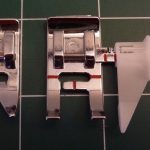Since becoming serious about my sewing, I have purchased a number of specialty presser feet. One of them is a binder presser foot or bias binder foot. In this post I review what a binder presser foot looks like and what it can be used for.
What does it look like?
If you’re familiar with a universal presser foot (aka zigzag presser foot) you will notice that a binder presser foot is wider and longer. A rigid support holds a hollow, conical trough and support platform parallel to the main part of the binder foot. On the left is my universal presser foot and on the right is my binder presser foot. These are both low-shank, snap on feet.

Here are some closeups of my binder presser foot.



Specific binder presser feet are available for most brands of sewing machine. Alternatively look for a universal bias binder presser foot that is compatible with several brands of sewing machines.
What does it do?
A bias binder foot is used to sew a strip of continuous bias or binding into a flat cord. It’s also used to sew bias or binding strips to the raw edges of other fabrics to prevent fraying. You can also used an adjustable bias foot to complete these tasks, but the two feet are quite different.

Each binder foot is meant to be used with a specific width of bias or binding strip and different models of binder feet accommodate different widths of bias or binding strips. Each adjustable bias foot can be used with several widths of bias or binding tape. Bias tape and binding tape are folded strips of fabric and bias strips and binding strips are not.
How does it work?
My binder foot didn’t come with instructions so I referred to Heather Valentine’s video How To Use A Bias Binder Foot
Feed a narrow strip of fabric (continuous bias strip or a binding strip) into the cone of the binder foot then under the square part of the binder foot. Next attach the foot to your sewing machine. As you sew the strip will be folded and sewn into a cord.

The vertical screw can be used to adjust the position of the cone and where the bias/binding strip will be stitched. Note the jump in the stitches in the below photo resulting from adjusting the position of the cone.

Slide a piece of fabric inside the middle part of the cone and the binding strip will be sewn along its edge.

Conclusion
If you want to finish a seam with bias or binding strips, a binder foot may be helpful. If you’re using bias or binding tape, an adjustable bias foot may be helpful. A universal foot and lots of pins or fabric clips will also get these jobs done.
I’ve been testing my binder foot with different strips of binding. I’ve had some issues getting a good result and I’m not sure if it has to do with the width of my strips or the thickness of my fabrics. I’ll update this post when I have more definitive information.
Have you used a bias binder presser foot? Do you have advice for people considering purchasing one or having difficulty with theirs? Comment below and/or Pin Me for later.
Tanya

Help support Sewn By Tanya
If you love what I do, have learned from reading my blog, and/or want to support my work financially, consider becoming a Sewn By Tanya patron. Your monthly donation of $1 or more will help Sewn By Tanya grow and expand. A minimum $6 per month gives you access to Sewn By Tanya Patreon only content. There’s so much I’d love to do and you can help make it happen.




